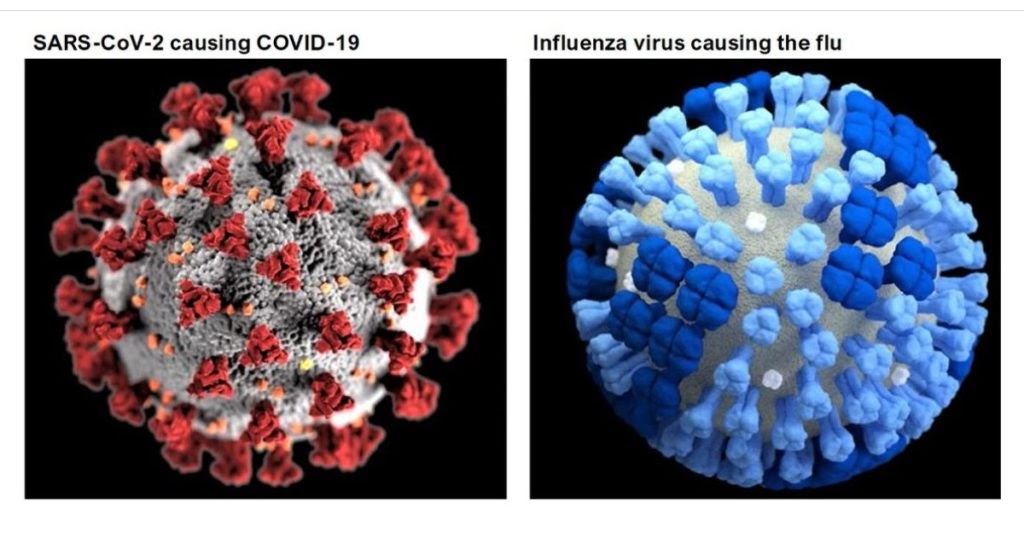SARS-CoV-2 is the coronavirus that emerged in late 2019. This virus causes a respiratory illness called COVID-19. In many people who contract COVID-19, the disease is mild, while in others, it presents more severely. COVID-19 shares many similarities and differences with seasonal influenza. Both COVID-19 and influenza cause respiratory illness with very similar symptoms, but there are also key differences between the two.

How is COVID-19 different from Influenza?
- Difference in Incubation Period between COVID-19 and Influenza
The incubation period is the time between the initial infection and the onset of symptoms. For COVID-19, the incubation period ranges from 2 to 14 days, while for influenza, it is shorter, averaging around 2 days (ranging from 1 to 4 days).
- Difference in Symptoms between COVID-19 and Influenza
The symptoms observed in COVID-19 typically include fever, cough, fatigue, and shortness of breath. Some individuals may also experience other symptoms, although these are less common, such as muscle aches, headache, runny or stuffy nose, sore throat, nausea or diarrhea, chills, fever and chills, and loss of smell or taste.
Some individuals infected with COVID-19 may not experience any symptoms, or may only have very mild symptoms.
In contrast, individuals with influenza may experience some or all of the following symptoms:
- Fever
- Chills
- Cough
- Fatigue
- Body aches
- Headache
- Runny or stuffy nose
- Sore throat
- Nausea or diarrhea
Fever is not seen in all cases of influenza and is more common in older adults or individuals with a weakened immune system.
Additionally, gastrointestinal symptoms such as vomiting and diarrhea are more common in children with influenza.
- Difference in the Onset of Symptoms of COVID-19 and Influenza
There are also differences in the way symptoms appear between COVID-19 and influenza. In COVID-19, initial symptoms are usually milder and gradually develop, whereas the onset of symptoms in influenza is often sudden.
Course of the Disease and its Severity
We are learning more and more about COVID-19 every day, but there are still aspects of the disease that are not fully understood. However, we know that there are specific differences in the course and severity of COVID-19 compared to influenza. About 20% of confirmed COVID-19 cases are severe or critical, and some individuals may experience more severe respiratory symptoms in the second week of illness, typically around 8 days after the onset.
On the other hand, regular influenza typically resolves within 3 to 7 days, although some individuals may experience coughing and fatigue for up to 2 weeks or more. Slightly more than 1% of individuals with influenza are hospitalized.
Transmission Period
The exact duration during which a person with COVID-19 can transmit the virus is still not fully understood. However, it is believed that individuals can transmit the virus as long as they have symptoms, and may even spread COVID-19 before symptoms appear. In contrast, an individual with influenza can spread the virus starting 1 day before symptoms develop, and can continue to spread the virus for 5 to 7 days after the onset of illness.

Why is this virus treated differently from Influenza?
Lack of Immunity
COVID-19 is caused by a new type of coronavirus known as SARS-CoV-2. Before its identification in late 2019, the virus and the disease it causes were unknown. The exact source of the coronavirus remains unclear, although it is believed to have an animal origin. Unlike seasonal influenza, there is no prior immunity to SARS-CoV-2, meaning the virus is entirely new to the immune system, and the body requires more effort to mount a response to fight the virus.
Severity and Mortality
COVID-19 is generally more severe than influenza, and data indicates that about 20% of people infected with COVID-19 experience severe or critical illness and require hospitalization and oxygen therapy. In contrast, a smaller percentage of individuals with influenza require hospitalization. However, the exact mortality rate for COVID-19 has varied in studies, depending on factors such as location and age group. Still, the estimated mortality rate for COVID-19 is higher than that of seasonal influenza, which is around 0.1%.

Transmission Rate
Although studies are ongoing, research suggests that a person infected with COVID-19 may potentially transmit the infection to more people than someone infected with influenza.
Will COVID-19 behave like seasonal Influenza?
Influenza is a seasonal illness, typically seen in the colder and drier months of the year. It is currently unclear whether COVID-19 will follow a similar pattern.
Does the coronavirus have the same outbreak potential as Influenza?
The Centers for Disease Control and Prevention (CDC) recommends that everyone in public spaces where maintaining a 2-meter distance from others is difficult should wear a cloth face mask. This helps reduce the spread of the virus from asymptomatic individuals or those who do not know they are infected. Both COVID-19 and influenza are transmitted through respiratory droplets produced when an infected person exhales, coughs, or sneezes. If another person inhales these droplets or touches a contaminated surface and then touches their face, mouth, nose, or eyes, they may become infected.
Who is at Higher Risk for Severe Illness?
There is significant overlap between the groups at risk for both COVID-19 and influenza. Factors that increase the risk of severe disease for both include:
- Age 65 and older
- Living in a long-term care facility, such as a nursing home
- Having underlying health conditions, such as asthma, chronic lung diseases, a weakened immune system (due to transplants, HIV, cancer treatments, or autoimmune diseases), diabetes, heart disease, kidney disease, liver disease, and obesity.
Additionally, pregnant women and children under 2 years old are also at higher risk for severe disease from influenza.
What Should You Do If You Experience Symptoms of COVID-19?
Stay at home and limit contact with others while monitoring your symptoms. People with mild illness often recover at home. However, continue to monitor your symptoms, as they may worsen due to the infection. Contact your doctor to inform them of your symptoms. Use a face mask, and if you live with others or need to go out for medical care, wear a surgical mask.
COVID-19 and influenza are both respiratory diseases. While there is significant overlap, there are also fundamental differences that need to be considered.












Our Customers' Comments
No comments registered